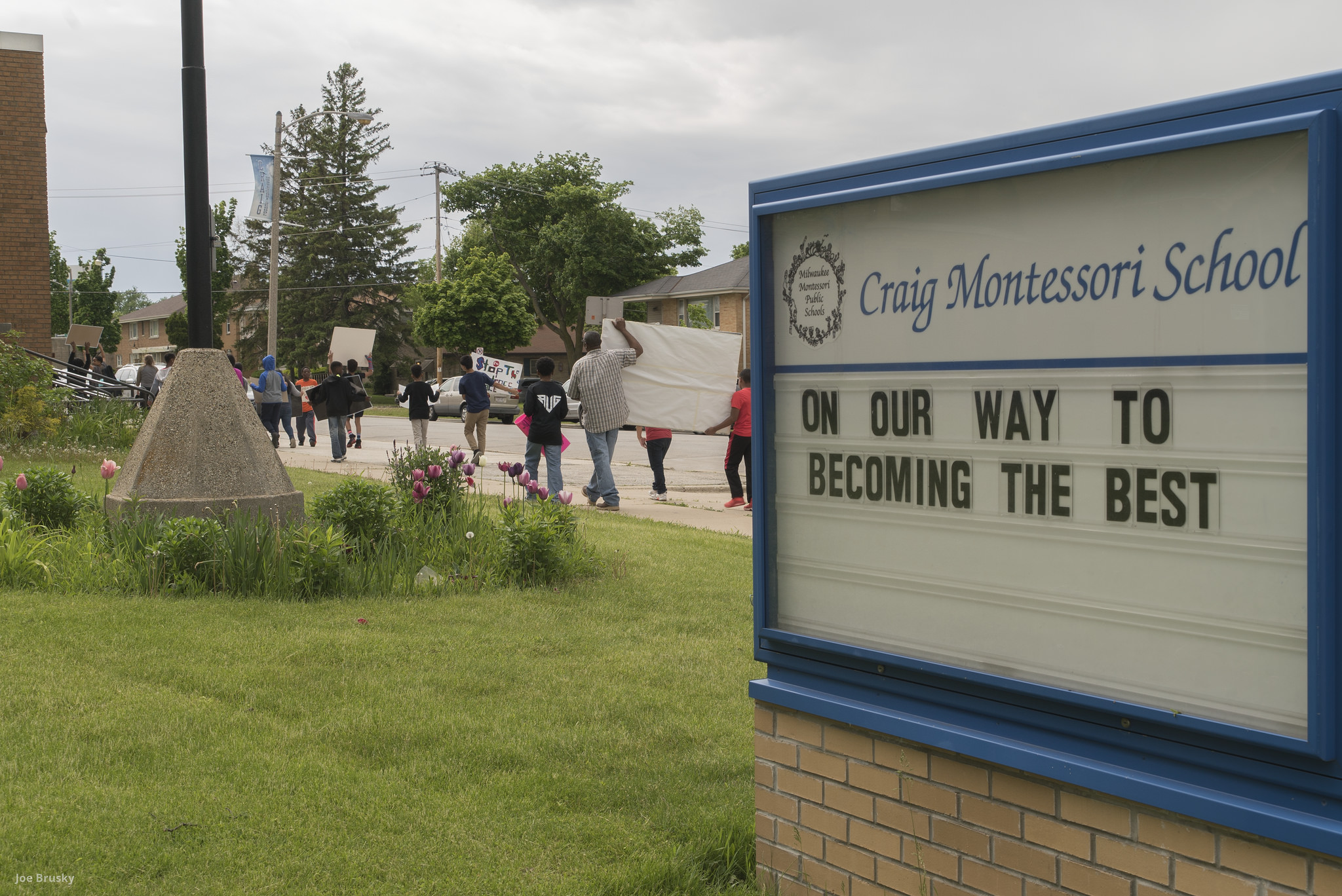The term Montessori refers to the educational method developed by Dr. Maria Montessori (1870-1952).[1] Montessori, an Italian physician, gained world-wide recognition for an academically focused program meeting “the needs of the young child” through multi-aged groupings, constructivist curriculum, and hands-on materials.[2] A Montessori classroom is ideally an exploratory environment with young students developing self-chosen skills through carefully controlled materials, while older students are pursuing what they want to learn and attending small group presentations across the defined curriculum areas.
The Milwaukee metro area includes eight public and six private Montessori schools (2016). Generally, schools in Milwaukee are largely staffed with teachers trained by the Association Montessori Internationale (AMI). Teachers are specially certified, either early childhood or elementary, through the Montessori Institute of Milwaukee (MIM).[3]
The first school, Milwaukee Montessori School (1961) on Milwaukee’s near West Side, was a private school led by Hildegard Solzbacher, who is credited with spreading Dr. Montessori’s methods in Milwaukee through a series of public lectures at Marquette University.
Public schools introduced Montessori education at Edward A. MacDowell (1976), the earliest in the country to publicly fund Montessori education for four-year-olds.[4] Grace Iacolucci, Early Childhood Specialist for the Milwaukee Public Schools (MPS), was instrumental in forming four MPS Montessori pre-kindergartens in 1973 at separate locations. These would coalesce in 1976 into MacDowell Montessori School.[5] Later, the Milwaukee Board of School Directors extended free Montessori education starting with three-year-olds (1981) and through high school (2012).
The prime factor in creating a public Montessori school was the 1976 federal court order mandating that MPS desegregate its schools. Montessori was one of several educational models selected to attract white parents to schools located in predominantly black neighborhoods, a hallmark of the Milwaukee desegregation plan. Parents who gained entry (by lottery) into MacDowell recognized an excellent educational approach. Parent advocacy led the Milwaukee Board of School Directors to gradually open additional Montessori schools.[6]
Also driving Montessori expansion in the early years was a West Side group of parents wanting Montessori education. Their effort resulted in Highland Community School (1968). The school’s three organizing themes of integration, parent power, and Montessori education gained recognition across the city.[7] In 1996 the school became the first independent charter school in Wisconsin funded by Milwaukee Public Schools. Its parent board has retained control of the school.
Even earlier, Dr. Jon and Barbara Osterkorn began Via Marsi Montessori School (1967) on Milwaukee’s West Side for Milwaukee pre-school children with exceptional educational needs. Research had shown Montessori education methods to be effective for children with disabilities. The school is now attached to the Penfield Children’s Center.
Montessori schools have increased in number and size, from approximately two hundred public school students in 1976 to over three thousand public and one thousand private school students in 2016. This number exceeds the size of several metro-Milwaukee public school districts. Along with the increase in private schools, one suburban district also began a Montessori program.[8]
Footnotes [+]
- ^ Montessori’s early work at the Rome University Psychiatric Clinic led her to the observation that toddlers and young children have an inner drive to learn from their surroundings. She created materials and child-sized furniture (first of its kind), allowing children to follow their natural tendencies. The results were levels of early achievement not previously believed possible.
- ^ Angeline Stoll Lillard, Montessori: The Science behind the Genius (New York, NY: Oxford University Press, 2005), 17.
- ^ In the United States, the two predominant Montessori teacher-training organizations are the Association Montessori Internationale-USA (AMI-USA) and the American Montessori Society (AMS). In Milwaukee Public Schools, teachers have Wisconsin Department of Instruction certification as well as either AMI or AMS training.
- ^ In Cincinnati, the public Sands Montessori School opened in 1975 but was provided private funding to support its pre-school program.
- ^ Tim Duax, “Milwaukee: Ten Constructive and Influential Years 1976-1986: A Montessori Program in the Public Schools,” NAMTA Journal 12-2 (1987): 32-35.
- ^ Public Montessori schools in Milwaukee as of 2016, listed by start date, are MacDowell (1976); Greenfield (now Fernwood) (1983); Craig (1996); Highland Community School (charter) (1996); Maryland Avenue (2001); Kosciuszko (2005, closed 2012); Lloyd Barbee (2009); and Howard Avenue (2012).
- ^ Michael Williams, The Parent-Centered Early School: Highland Community School of Milwaukee (New York & London: Garland Publishing, 1997).
- ^ Private schools in the Milwaukee metro area are: Amy Montessori School, Downtown Montessori Academy, Mequon Montessori School, Milwaukee Montessori School, New World Montessori School, and North Shore Montessori School. The suburban public school is Wauwatosa Montessori School (opened 2012).
For Further Reading
Duax, Tim. “Milwaukee: Ten Constructive and Influential Years 1976-1986: A Montessori Program in the Public Schools.” NAMTA Journal 12-2 (1987): 32-35.
Kramer, Rita. Maria Montessori: A Biography. Boulder: Westview Press, 1988.
Lillard, Angeline Stoll. Montessori: The Science behind the Genius. New York: Oxford University Press, 2005.
Williams, Michael R. The Parent-Centered Early School: Highland Community School of Milwaukee. New York & London: Garland Publishing, 1997.

0 Comments
Please keep your community civil. All comments must follow the Encyclopedia of Milwaukee Community rules and terms of use, and will be moderated prior to posting. Encyclopedia of Milwaukee reserves the right to use the comments we receive, in whole or in part, and to use the commenter's name and location, in any medium. See also the Copyright, Privacy, and Terms & Conditions.
Have a suggestion for a new topic? Please use the Site Contact Form.